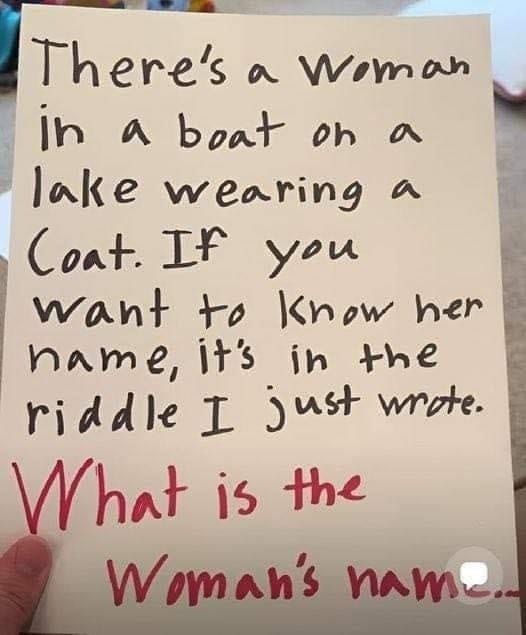Have you ever stumbled upon a riddle that feels utterly unsolvable—until suddenly, it all clicks? That’s the magic behind this viral brain-teaser. It’s deceptively simple, irresistibly clever, and once you crack it, you’ll be kicking yourself for not seeing the answer sooner. Let’s dive in and unravel the twist that’s been stumping so many.
Cracking the Code: Breaking Down the Riddle
Here’s how the riddle goes:
“There’s a woman in a boat on a lake wearing a coat. If you want to know her name, it’s in the riddle I just wrote.”
At first glance, it seems like a simple scene—a woman, a boat, a lake, and a coat. But don’t let the calm setting fool you. The real key is hidden in plain sight, right in the final line: “It’s in the riddle I just wrote.” That line is more than just a hint—it’s the solution’s foundation.
Let’s take a closer look at what’s really going on here…
Discovering the Hidden Name
Let’s zoom in on the crucial clue: “There’s a woman.”
Read that again. See it? Hidden right within the phrase is the name itself—“There.”
Surprised? That’s exactly why this riddle works so well. It draws you in with a straightforward scene, then flips your expectations. The answer isn’t in the setting, the objects, or the woman’s outfit—it’s in the words themselves.
What makes this riddle so clever is that it feels like it should be complex. But the solution? Hiding in plain sight the entire time.
Why This Riddle Is So Effective
1. It’s a Masterclass in Misdirection
When we hear “riddle,” our minds go into detective mode. We start analyzing every detail—wondering if “Coat” sounds like “Kate,” or if “Lake” is a clue for “Lacy.” But that’s the trap. These distractions pull your attention away from the obvious answer right in front of you.
2. It Exploits Our Tendency to Overthink
Most of us assume riddles require deep logic or obscure references. This one flips that instinct on its head by being too simple to believe. It knows you’ll dig deeper—and that’s how it slips past your radar.
3. It Leans on a Classic Riddle Trick
This style of wordplay is common in brain teasers that play with literal interpretation. Like the one that asks:
“I start with a ‘T,’ end with an ‘E,’ and have an ‘H’ in the middle. What am I?”
Answer: “The.”
It’s clever, it’s self-referential, and it’s all about reading between the lines—literally.
The Psychology of Wordplay Riddles
These riddles tap into a unique corner of the brain: the part that loves patterns but hates being tricked. When you finally “get it,” there’s a little burst of satisfaction, like solving a mini puzzle. It’s not just about the answer—it’s about the journey your mind takes to get there.

Why Our Brains Fall for Riddles Like This
Riddles like these thrive on how our brains naturally operate. They don’t just test our knowledge—they play with our instincts, tapping into how we process information:
- We look for patterns – Our minds instinctively search for familiar names or clues, even when none exist.
- We overlook the obvious – When told the answer is “in the riddle,” we assume it must be cleverly hidden, not simply there.
- We expect complexity – Instead of accepting the straightforward, we dig for depth that isn’t needed.
And that’s what makes these puzzles so brilliant—they’re a psychological tug-of-war. You’re not just solving a riddle; you’re unlearning your own overthinking. It’s frustrating, funny, and incredibly satisfying all at once.
More Mind-Bending Riddles with the Same Twist
If you loved the “woman in the boat” brain-teaser, you’ll probably enjoy these classic riddles that follow the same playbook—deceptively simple, but sneakily clever:
- 🪙 “What has a head, a tail, but no body?”
→ A coin. - ⏳ “What comes once in a minute, twice in a moment, but never in a thousand years?”
→ The letter ‘M’. - 👣 “The more you take, the more you leave behind. What am I?”
→ Footsteps.
Each one steers your thinking off course before revealing that the answer was staring you down the whole time.
Final Thoughts
Riddles like these are more than just word games—they’re tiny tests of perception. They remind us that sometimes, the hardest part of solving a problem is letting go of what we think we know. And when the lightbulb finally goes off? That little moment of “Aha!” is pure magic.
Want even more clever riddles or wordplay puzzles like this? I can pull together a whole list for you!

Why Riddles Are More Than Just Fun
Riddles aren’t just a source of amusement—they’re a fantastic workout for your brain! They sharpen problem-solving skills, boost memory, and even enhance language development. Whether you’re solving them solo or challenging friends and family, riddles provide a fun and effective way to exercise your mind.
Conclusion: The Simple Genius Behind the Riddle
So, what’s the answer to this viral riddle? It’s “There.” The beauty of this puzzle lies in its simplicity: the phrase “There’s a woman” already contains the answer. It’s a clever example of how a simple twist in language can both confuse and entertain.
Next time you come across a riddle, remember: sometimes the most straightforward answer is hiding right under your nose!
